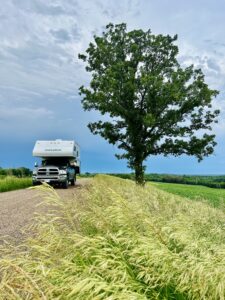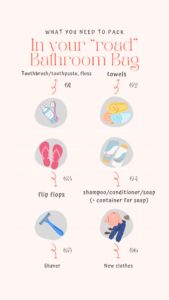“Find home wherever you are”
The morning is rolling around here in this indescribably beautiful valley within the mountains of Valle Hermoso. It’s 9:30 am, and the sun is just about to peek over the mountains. Last night, we pulled in after an exhilarating off-road ride through the mountains from Route 40. After almost every turn, another beautiful landscape emerged: from red rock to desert plants, to beautiful streams and rivers. I could see excitement spill over into a smile on Emi’s face every time he shifted the gear from 2WD to 4WD. And that’s when I knew to hold on tight! We enjoyed a quick salad about halfway, full of protein and fiber.

Despite the gorgeous views and nutritious food, the inevitable happened when we hit 3,000 feet above sea level. I experienced a little headache and a bit of nausea, but nothing wild. We did some breathing exercises, which helped for a bit. Emi studied mountaineering growing up, so his body naturally acclimates to higher altitudes. I consider myself pretty outdoorsy and tough, but there’s no hiding the fact that I’m from the Manitoban Prairies, possibly the flattest place on earth, so I was struggling. We pulled in, set up camp, and went for a little stroll. I made some chili and bread on the propane stove, Emi made a beautiful fire, and everything was perfect—until my body decided to completely shut down. Out of guilt for not being able to hack it, I tried to eat some chili, but my body quickly rejected it, and I crawled into bed while Emi put everything away.
We’re apparently at 2,200 feet above sea level, which Emi thinks is the reason for my altitude sickness. I can’t say I’ve ever felt like this before, so it was quite the eye-opener and something to think about if you’re heading up this way. I woke up to an angel. Who just happened to be Tito, the camp dog. We all know, dogs sense when you’re in pain, and this beautiful creature crawled into bed with me and has been following me around.

We’re planning to go for a little hike to some hot springs that the grumpy owner here says you can reach by crossing two rivers. I’m currently chugging coffee and trying to put something in my stomach that will stay down and give me some energy. I look like a zombie, but I’m determined to experience everything. Emi is a champ; he’s been taking care of me so well. I’m so lucky.
Later today, we are hoping to eat some chivo, which is goat. Emi says that traditionally, the animal is killed in front of you so you can see that the process is done properly. You then have to wait for the blood to drain before they butcher and cook it in an asado at a low temperature. I’m guessing you can only get it around these parts because he said that he and his friends would drive all the way down just to get this. In my opinion, although it’s hard to see and hear, this is how everyone should eat meat (if they eat meat). In Canada, we walk into the grocery store and pick the nicest-looking cut of meat without knowing anything about how it died, the process of it being killed, or how it lived. For a life taken, I think we should at least learn more about the process out of respect.
In Canada, one of my favorite aspects of Indigenous cultural practices is that when they kill an animal or cut down a tree, they offer the land some tobacco in appreciation for feeding them, providing shelter, and sacrificing its life. I’m paraphrasing, but that’s the gist. Beautiful.
So, wish me luck that I don’t pass out from malnutrition halfway through the hike, and hopefully, I can keep something down to keep the adventure going! If you’re struggling to find good info on altitude sickness like I was, check out this super cool lady’s blog: The Best Foods and Drinks for Acclimatising to High Altitude. As a nutrition coach, I know these are the things I need right now: hydration, potassium, and complex carbs. These are the things I was actually able to keep down. Everyone’s different, but when you’re feeling sick, keep it simple. Don’t reach for highly processed foods (nor should you ever); keep it very clean.
Best foods for altitude sickness (and why):
If I could go back in time, I would do a little more research on how to prepare for high altitudes. Before your big hike or trip into the mountains, try to limit your alcohol intake (it dehydrates you). Increase your potassium intake (an electrolyte that helps with cramping) and boost your vitamins and minerals to supercharge your immune system. While you’re up there, remember that you are burning significantly more energy, so increasing your carbohydrate intake is a good idea. Try to reach for complex carbohydrates instead of refined sugar to avoid a crash and further dehydration. Make sure you’re drinking enough water to support your activity.
-
- Bananas, Sweet Potato, Avocado, Dates: all super high in potassium.
-
- Green apples: Fiber, vitamins and pectin, which helps neutralize stomach acid.
-
- Amazing grass superfood greens: This powder checks all the boxes for you. I’ve been using it for years, especially while traveling to places that I don’t have access to fresh fruits and veg. https://a.co/d/fIU9Glz
-
- Water and electrolytes: clearly water is a must. Especially if you’re actually throwing up. “electrolytes” can be honey, lemon and salt. But if you want to just buy it this one is good!: LMNT https://a.co/d/3MNg61F
-
- Complex Carbohydrates: oats, brown rice, whole grain bread, sweet potato. I like to make these Road Oat cookies for any of our adventures because they give us sustainable energy, protein and fiber while not feeling like a brick in the tummy. If you don’t have access to an oven and you want to just buy them here’s the best I can find health wise on Amazon “Nairn’s”: https://a.co/d/0hx5VWZ3
Thanks for reading, hope you have an amazing day !
L+E
Read about what to Pack on your next trip to Argentina here:

Buying a Used RV/Truck Camper: Cost Realities + What to Consider Before You Buy!
So you wanna live the “Vanlife”? let’s make sure you buy something that fits your lifestyle AND your Budget. #1: Are you ready to live

What to Pack For Argentinian Winters (Mendoza / Bariloche)
I was not prepared. And embarrassed as a Canadian that I didn’t dress properly. Mendoza switched quickly from HOT to COLD. From thinking I didn’t

Bathroom Bag Checklist
Squeaky Clean on the GO ! Sometimes it’s a nice hot shower, sometimes it’s a beach shower, sometimes it’s a sink shower, sometimes it’s a
Beach Bag Checklist
The beach is a therapeutic place for both Emi and I. Even as a kid growing up in Manitoba, spending a day curling my toes

